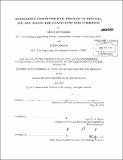Estimating commuter rail demand to Kendall Square along the Grand Junction Corridor
Author(s)
Bockelie, Adam; Dohm, James
DownloadFull printable version (8.986Mb)
Other Contributors
Massachusetts Institute of Technology. Dept. of Civil and Environmental Engineering.
Advisor
Nigel H. M. Wilson.
Terms of use
Metadata
Show full item recordAbstract
Since acquiring the Grand Junction Railroad in June 2010 from CSX, the Massachusetts Bay Transit Authority (MBTA) has explored the possibility of using the line for commuter rail service. In addition the Grand Junction right-of-way has been the subject of other proposals, including a multi-use path by the City of Cambridge and a Bus Rapid Transit (BRT) line as part of the MBTA's Urban Ring study. In September of 2010, our team was asked to examine the possibility of adding passenger service along the Grand Junction Railroad in Cambridge, MA. This new service would allow the current Worcester/Framingham commuter rail line to serve both North and South stations. In response, we performed an analysis based on the existing conditions of the railroad and projected future growth of the Kendall Square business area. To perform this analysis a demand model was developed using the 2010 MIT Transportation Survey and 2000 Census Bureau Journey to Work data. The demand model was used to forecast ridership on the Grand Junction Railroad, for multiple alternatives which included the addition of a commuter rail station at Kendall Square, use of diesel multiple units to improve frequency, and a short high frequency route starting at Auburndale. The results of the analysis demonstrate that a high frequency service from Worcester along the Grand Junction Corridor attracts the most riders, approximately 1,800 peak morning commuters. With the Auburndale service and lower frequency Worcester trains having moderate ridership estimates. This forecast combined four types of riders: new inbound riders to Kendall Square, redirected inbound riders to Kendall Square, new inbound riders to Boston, and redirected reverse riders from North Station. In addition to demonstrating how the demand model and the rider survey dataset were developed this report provides a framework for a more detailed study into potential uses for passenger service along the Grand Junction Railroad.
Description
Thesis (M. Eng.)--Massachusetts Institute of Technology, Dept. of Civil and Environmental Engineering, 2012. Cataloged from PDF version of thesis. Includes bibliographical references (p. 113-114).
Date issued
2012Department
Massachusetts Institute of Technology. Department of Civil and Environmental EngineeringPublisher
Massachusetts Institute of Technology
Keywords
Civil and Environmental Engineering.